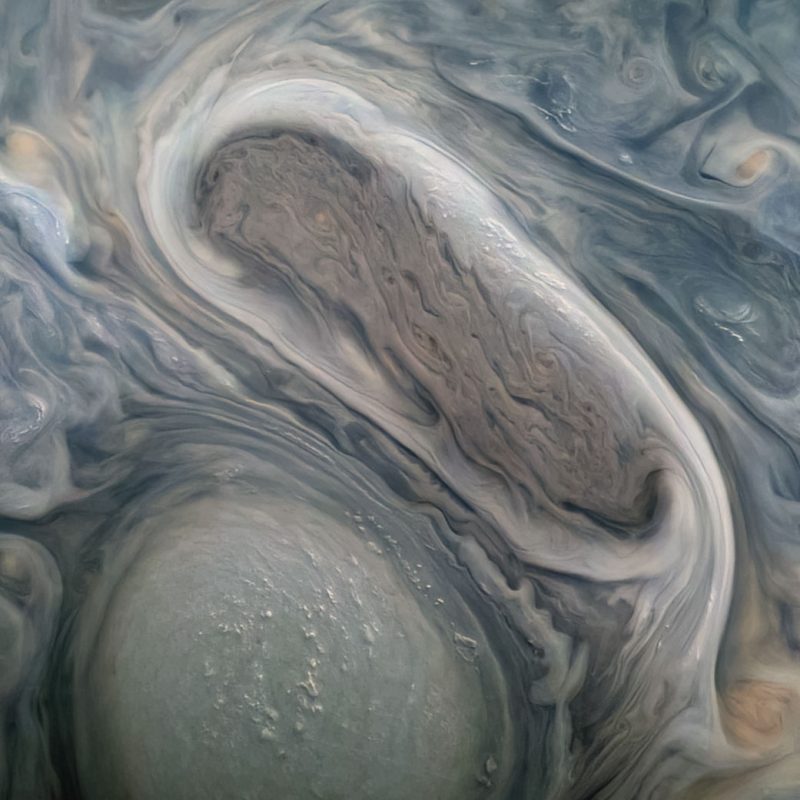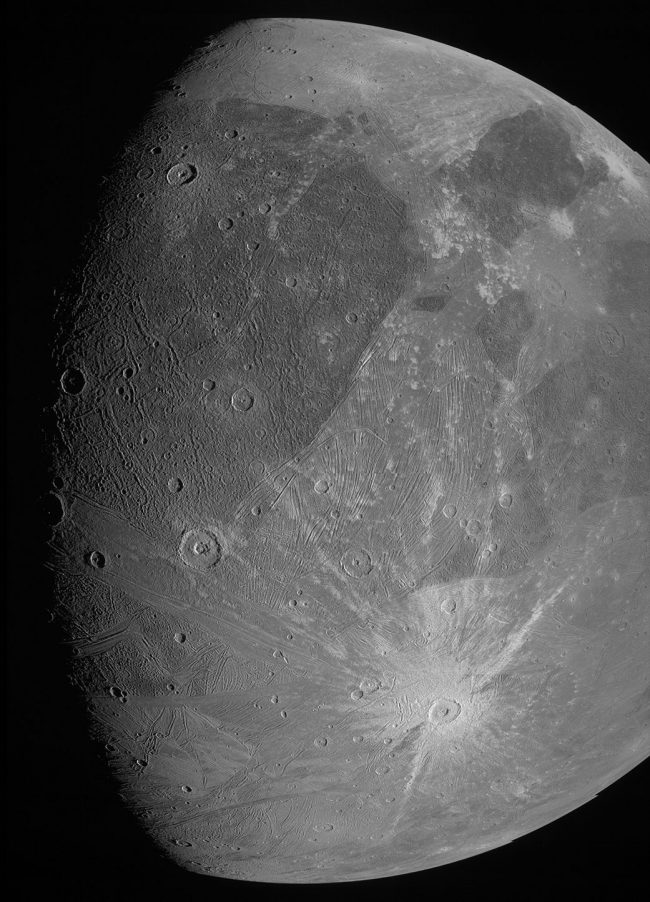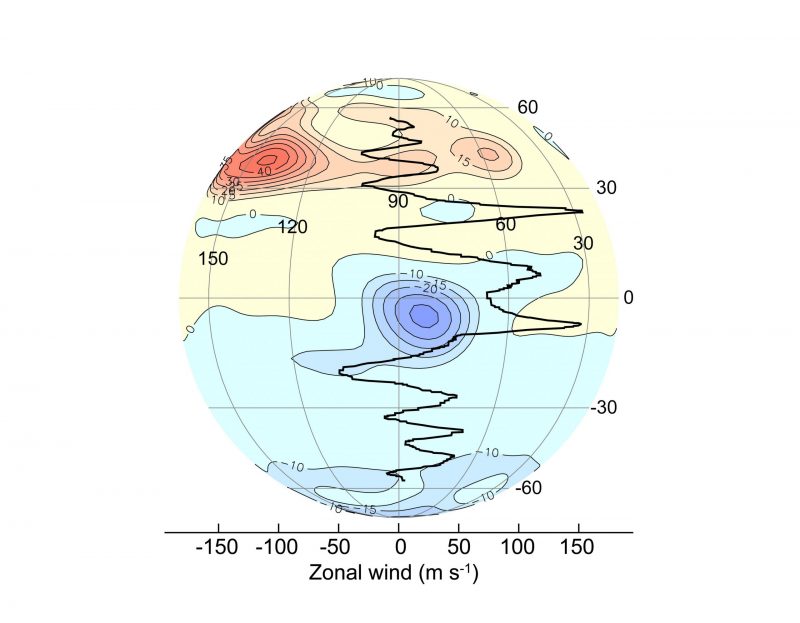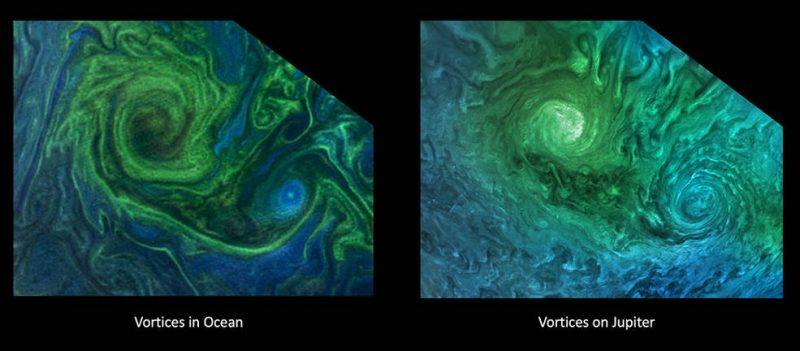
1. Juno ‘hears’ Jupiter’s moon Ganymede
An audio track collected during the Juno mission’s recent close flyby of the large Jupiter moon Ganymede was a highlight shared by Juno mission scientists at 2021’s fall meeting of the American Geophysical Union, held shortly before Christmas in New Orleans. Juno Principal Investigator Scott Bolton shared the 50-second audio track generated from data collected during Juno’s June 7 flyby. Bolton said:
This soundtrack [below] is just wild enough to make you feel as if you were riding along as Juno sails past Ganymede for the first time in more than two decades. If you listen closely, you can hear the abrupt change to higher frequencies around the midpoint of the recording, which represents entry into a different region in Ganymede’s magnetosphere.
At the time of Juno’s closest approach to Ganymede – during the mission’s 34th trip around Jupiter – the spacecraft was within 645 miles (1,038 kilometers) of Ganymede’s surface and traveling at a relative velocity of 41,600 mph (67,000 kph). Juno’s Waves instrument, which tunes in to electric and magnetic radio waves produced in Jupiter’s magnetosphere, collected the data. Scientists then shifted the frequency into the audio range to make the audio track below.
EarthSky lunar calendars are back in stock! We’re guaranteed to sell out – get one while you can.

2. A magnetic Great Blue Spot
Jack Connerney of NASA’s Goddard Space Flight Center said at the fall AGU meeting that he and his team have produced the most detailed map yet obtained of Jupiter’s magnetic field. The map is compiled from data collected from 32 orbits during Juno’s prime mission. The scientists said it provides new insights into the gas giant’s mysterious Great Blue Spot, a magnetic anomaly at the planet’s equator. Juno data indicate that a change in the gas giant’s magnetic field has occurred during the spacecraft’s five years in orbit. The Great Blue Spot is drifting eastward at a speed of about 2 inches (4 centimeters) per second relative to the rest of Jupiter’s interior. At that rate, the Great Blue Spot should lap the planet in about 350 years.
In contrast, the Great Red Spot – the long-lived atmospheric anticyclone just south of Jupiter’s equator – is drifting westward at a relatively rapid clip, lapping the planet in only about 4 1/2 years.
In addition, the new map shows that Jupiter’s zonal winds are pulling the Great Blue Spot apart. Zonal winds are jet streams that run east to west and west to east, giving Jupiter its distinctive banded appearance. This means that the zonal winds measured on the surface of the planet reach deep into the planet’s interior.
The new magnetic field map also enables Juno scientists to make comparisons with Earth’s magnetic field. The data suggest to the team that dynamo action – the mechanism by which a celestial body generates a magnetic field – in Jupiter’s interior occurs in metallic hydrogen, beneath a layer expressing helium rain.

3. Earth’s oceans, Jupiter’s atmosphere
Lia Siegelman is a physical oceanographer and postdoctoral fellow at Scripps Institution of Oceanography at the University of California, San Diego. She decided to study the dynamics of Jupiter’s atmosphere after noticing that the cyclones at Jupiter’s pole appear to share similarities with ocean vortices she studied during her time as a doctoral student. Siegelman said:
When I saw the richness of the turbulence around the Jovian cyclones, with all the filaments and smaller eddies, it reminded me of the turbulence you see in the ocean around eddies. These are especially evident in high-resolution satellite images of vortices in Earth’s oceans that are revealed by plankton blooms that act as tracers of the flow.
NASA explained:
The simplified model of Jupiter’s pole shows that geometric patterns of vortices, like those observed on Jupiter, spontaneously emerge and survive forever. This means that the basic geometrical configuration of the planet allows these intriguing structures to form.
Although Jupiter’s energy system is on a scale much larger than Earth’s, understanding the dynamics of the Jovian atmosphere could help us understand the physical mechanisms at play on our own planet.

4. Juno image of Jupiter’s thin ring
At the fall AGU meeting, the Juno team has also released its latest image of Jupiter’s faint dust ring, taken from inside the ring looking out by the spacecraft’s Stellar Reference Unit navigation camera. NASA said:
The brightest of the thin bands and neighboring dark regions seen in the image are linked to dust generated by two of Jupiter’s small moons, Metis and Adrastea. The image also captures the arm of the constellation Perseus.
Heidi Becker, lead co-investigator of Juno’s Stellar Reference Unit instrument at NASA’s Jet Propulsion Laboratory in Pasadena, said:
It is breathtaking that we can gaze at these familiar constellations from a spacecraft a half-billion miles away. But everything looks pretty much the same as when we appreciate them from our backyards here on Earth.
It’s an awe-inspiring reminder of how small we are and how much there is left to explore.

Bottom line: Juno has been studying Jupiter and its moons since it arrived at the giant planet in 2016. Here are four of its latest discoveries, presented at the December 2021 meeting of the American Geophysical Union.
The post Juno spacecraft’s 4 latest discoveries at Jupiter first appeared on EarthSky.
from EarthSky https://ift.tt/3yY9bHt

1. Juno ‘hears’ Jupiter’s moon Ganymede
An audio track collected during the Juno mission’s recent close flyby of the large Jupiter moon Ganymede was a highlight shared by Juno mission scientists at 2021’s fall meeting of the American Geophysical Union, held shortly before Christmas in New Orleans. Juno Principal Investigator Scott Bolton shared the 50-second audio track generated from data collected during Juno’s June 7 flyby. Bolton said:
This soundtrack [below] is just wild enough to make you feel as if you were riding along as Juno sails past Ganymede for the first time in more than two decades. If you listen closely, you can hear the abrupt change to higher frequencies around the midpoint of the recording, which represents entry into a different region in Ganymede’s magnetosphere.
At the time of Juno’s closest approach to Ganymede – during the mission’s 34th trip around Jupiter – the spacecraft was within 645 miles (1,038 kilometers) of Ganymede’s surface and traveling at a relative velocity of 41,600 mph (67,000 kph). Juno’s Waves instrument, which tunes in to electric and magnetic radio waves produced in Jupiter’s magnetosphere, collected the data. Scientists then shifted the frequency into the audio range to make the audio track below.
EarthSky lunar calendars are back in stock! We’re guaranteed to sell out – get one while you can.

2. A magnetic Great Blue Spot
Jack Connerney of NASA’s Goddard Space Flight Center said at the fall AGU meeting that he and his team have produced the most detailed map yet obtained of Jupiter’s magnetic field. The map is compiled from data collected from 32 orbits during Juno’s prime mission. The scientists said it provides new insights into the gas giant’s mysterious Great Blue Spot, a magnetic anomaly at the planet’s equator. Juno data indicate that a change in the gas giant’s magnetic field has occurred during the spacecraft’s five years in orbit. The Great Blue Spot is drifting eastward at a speed of about 2 inches (4 centimeters) per second relative to the rest of Jupiter’s interior. At that rate, the Great Blue Spot should lap the planet in about 350 years.
In contrast, the Great Red Spot – the long-lived atmospheric anticyclone just south of Jupiter’s equator – is drifting westward at a relatively rapid clip, lapping the planet in only about 4 1/2 years.
In addition, the new map shows that Jupiter’s zonal winds are pulling the Great Blue Spot apart. Zonal winds are jet streams that run east to west and west to east, giving Jupiter its distinctive banded appearance. This means that the zonal winds measured on the surface of the planet reach deep into the planet’s interior.
The new magnetic field map also enables Juno scientists to make comparisons with Earth’s magnetic field. The data suggest to the team that dynamo action – the mechanism by which a celestial body generates a magnetic field – in Jupiter’s interior occurs in metallic hydrogen, beneath a layer expressing helium rain.

3. Earth’s oceans, Jupiter’s atmosphere
Lia Siegelman is a physical oceanographer and postdoctoral fellow at Scripps Institution of Oceanography at the University of California, San Diego. She decided to study the dynamics of Jupiter’s atmosphere after noticing that the cyclones at Jupiter’s pole appear to share similarities with ocean vortices she studied during her time as a doctoral student. Siegelman said:
When I saw the richness of the turbulence around the Jovian cyclones, with all the filaments and smaller eddies, it reminded me of the turbulence you see in the ocean around eddies. These are especially evident in high-resolution satellite images of vortices in Earth’s oceans that are revealed by plankton blooms that act as tracers of the flow.
NASA explained:
The simplified model of Jupiter’s pole shows that geometric patterns of vortices, like those observed on Jupiter, spontaneously emerge and survive forever. This means that the basic geometrical configuration of the planet allows these intriguing structures to form.
Although Jupiter’s energy system is on a scale much larger than Earth’s, understanding the dynamics of the Jovian atmosphere could help us understand the physical mechanisms at play on our own planet.

4. Juno image of Jupiter’s thin ring
At the fall AGU meeting, the Juno team has also released its latest image of Jupiter’s faint dust ring, taken from inside the ring looking out by the spacecraft’s Stellar Reference Unit navigation camera. NASA said:
The brightest of the thin bands and neighboring dark regions seen in the image are linked to dust generated by two of Jupiter’s small moons, Metis and Adrastea. The image also captures the arm of the constellation Perseus.
Heidi Becker, lead co-investigator of Juno’s Stellar Reference Unit instrument at NASA’s Jet Propulsion Laboratory in Pasadena, said:
It is breathtaking that we can gaze at these familiar constellations from a spacecraft a half-billion miles away. But everything looks pretty much the same as when we appreciate them from our backyards here on Earth.
It’s an awe-inspiring reminder of how small we are and how much there is left to explore.

Bottom line: Juno has been studying Jupiter and its moons since it arrived at the giant planet in 2016. Here are four of its latest discoveries, presented at the December 2021 meeting of the American Geophysical Union.
The post Juno spacecraft’s 4 latest discoveries at Jupiter first appeared on EarthSky.
from EarthSky https://ift.tt/3yY9bHt

Aucun commentaire:
Enregistrer un commentaire